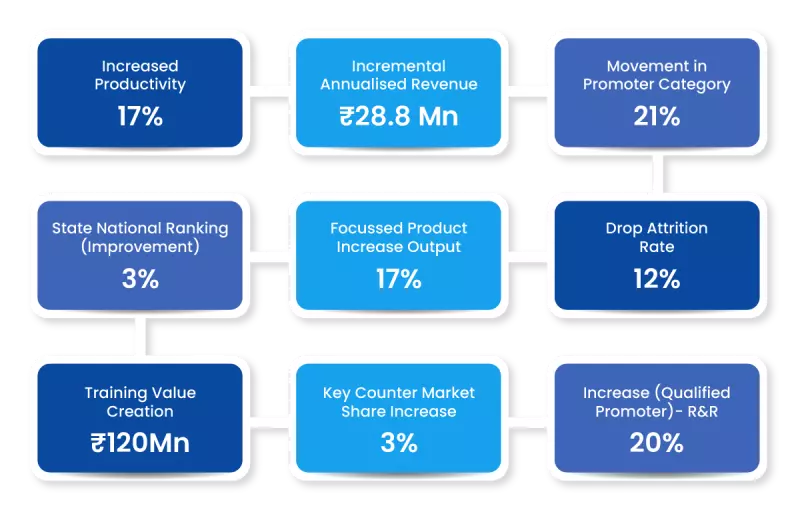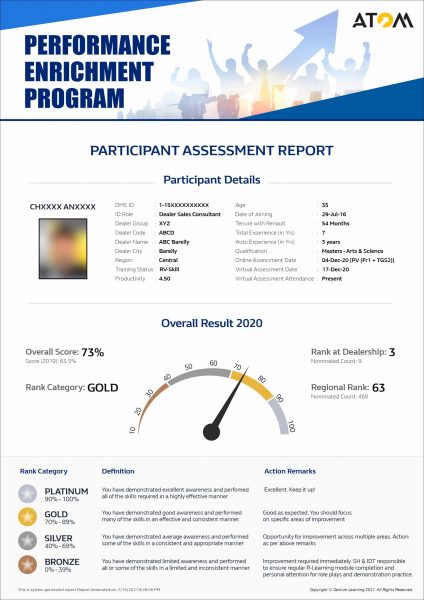Think about an individual report card for your salespersons that outlines the strengths and weaknesses for each of them with a customized plan of action to follow based on a thorough evaluation.
Though, there’s also a contrarian view to this that believes that sales is all about numbers and output, and hence it’s easy to assess, find and separate the best performers from the ones who require improvements solely through an analysis of their respective outputs.
The Importance of Inputs
There is no doubt, sales is majorly concerned with numbers but to achieve those numbers, there is a structured process that needs to be followed with consistency. Following this process in an effective manner involves a lot of inputs from the end of the sales personnel. The contribution of these inputs in the form of knowledge, skills, experience, and attitude is significant but invisible when you narrow down your focus merely on numbers. Deficiencies in inputs building up over a period of time can go unnoticed just like a disease. Hence, it’s important to have an extensive and regular diagnosis of your sales team to ensure their healthy and efficient functioning.
Assessment
While measuring output is certainly a straightforward process, how to measure inputs that are subjective in nature? This is possible through the process of assessment that lets you exhaustively scan the entirety of your sales team using modern tools and technology to detect gaps based on a weighted approach that assigns due load on the inputs.
You can obtain a detailed scorecard that covers comprehensive strengths and specific areas of development for each of your sales individuals just like a fitness report. The insights derived out of this practice possess the capability to do wonders for your organization. A question might arise in your mind- what’s the approach that needs to be followed while carrying out this sales team diagnosis or assessment?
Sharing two important live experiments with two of India’s leading brands wherein a personalized and comprehensive approach towards sales team diagnosis resulted in a complete paradigm shift and eventually set new benchmarks in enhancing the overall sales capability.
Example 1 – A Renowned Mobile Handset Company
Example one involves a large mobile handset company with over 25k promoters. Prior to our experiment, all the promoters were categorized into four categories based on business productivity. However, the entire approach was output-driven with no weightage assigned to internal traits such as knowledge, skillset, and attitude of promoters which also meant no parity among promoters of different category outlets.
Experiment–
- Part 1- A holistic assessment program was planned and employed based on important input parameters using three diagnostic tools in the form of assessment, role-plays, and QBDs (Question-based discussions). Based entirely on input elements with moderate weightage on the business output, promoters were further recategorized into four categories.
- Part 2- The promoters were then redeployed across 4 outlet categories. The redeployment followed a set pattern. Suppose a promoter who was initially a part of the A+ category based on output got classified as a B category promoter post an assessment on inputs, as a result he was consequently deployed at a C category outlet with an objective to enhance productivity for both the outlet and the promoter.
- Part 3 – The pilot was for a period of three months. Post pilot, the results were evaluated after rightfully taking into account all the associated factors such as seasonality, schemes, etc. Here’s an excerpt on the approach & broad result.
Promoter Assessment

Redeployment (Promoter)

Notice the increase in productivity as a result of input-based deployment
Result–
The complete experiment resulted in expanding the overall business productivity by 17% across the overall outlet category, eventually translating into incremental monthly revenue of ₹2.4 Mn and ₹28.8 Mn annually just for a single state. The experiment was felicitated as one of the best organizational practices, eventually serving as a benchmark at the entire South East Asia level for the mobile company. Case study
 The Assessment Dashboard shows the impact generation along key metrics
The Assessment Dashboard shows the impact generation along key metrics
By deploying promoters based on their input categories, we witnessed a significant change in terms of increase in productivity which reflects a positive relationship between the quality of inputs and the business productivity. With this, we dispelled the commonly held notion that sales is all about output. Merely reflecting upon the output can be alluring but do remember, it can deliver inaccurate insights proving to be detrimental in the long run.
Example 2 – A Multinational Automobile Major
A large automobile major with over 2000 sales advisors on ground faced a massive challenge around high attrition, low productivity, and low market share.
Experiment–
In a period of 15 days, we conducted a comprehensive assessment like the one we did in the previous example. The assessment was based on inputs- knowledge, skills & behaviour for over 2000 sales advisors. We deployed our in-house developed tool in the form of a cloud-based platform that’s highly secure, flexible, and scalable with advanced features such as facial recognition, On-the-fly analytics, and multilingual support, etc.

ATOM - eAssessment Platform
Result–
Based on the above assessment, all the advisors were categorized into four categories viz. Platinum, Gold, Silver, and Bronze.
Report Sample–

The generated report clearly articulated the defined area of focus for the reporting managers on corresponding strengths & AOD. The actionable insights from the report formed the basis to drive a completely personalized learning journey for the sales advisors.
The data produced can also be used to generate a predictive analysis of attrition and other driving factors. Therefore, facilitating the process of regular, effective, and proactive health check-up of your sales team.
These two examples suggest that regular check-ups or assessment of your sales team can actually help you locate the sources of the underlying inefficiencies. These inefficiencies have the potential to build up and add on trouble in various forms. Why not follow a proactive approach to detect and diagnose these issues before they emerge out and reflect in the performance?
Every sales individual is unique with respect to knowledge, skills, attitude, and problems. It’s imperative to address these distinctions through unique learning journeys that are crafted by the insights derived from input-based assessment.
If as a Business Head/Sales Leader/HR Leader, you could get an individual annual health card for your team, you certainly stand in an advantageous position to enhance the overall sales capability of your organization with surgical accuracy!


